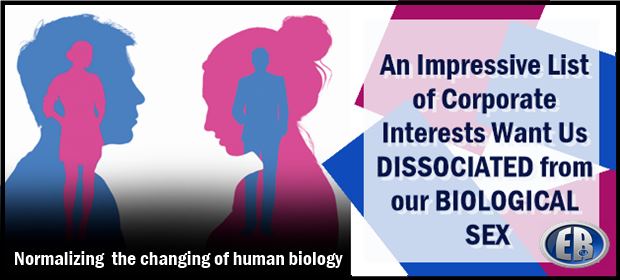
How a handful of billionaires created the transgender “movement”
An interview with Jennifer Bilek
First published at The European Conservative
I first came across investigative journalist Jennifer Bilek’s work in 2020, when her essay “The Billionaires Behind the LGBT Movement” was published in First Things. It was a stunning piece—there are several journalists committed to exposing the transgender ‘movement’ (or industry, as Bilek calls it), but nobody has peeled away the façade of civil rights, pink-and-blue flags, and ‘trans kids’ like Bilek. If we had a mainstream press truly committed to uncovering and reporting the truth about the forces driving our culture today, her work would be cited by them across the board.
Bilek is an artist, activist, and investigative journalist based out of New York City, and her work has been published in Tablet Magazine, The Federalist, The Post Millennial, and elsewhere. Bilek spent her life on the Left, but now she says that she is in the “political wilderness,” reporting on the biggest cultural story of our day while progressives ignore it or cover it up. Bilek also runs the Substack Jennifer’s Newsletter and the blog The 11th Hour, where she explains her focus:
I write at the intersection of humanity, technology, and runaway capitalism. At this intersection stands transgenderism, what I believe is a glamorous ad campaign generated by elites, invested in tech and pharma, to normalize the changing of human biology.
Bilek is doing something that journalists used to do instinctively: following the money. What she has uncovered is a bombshell that reveals the extent to which the transgender phenomenon has been created by super-wealthy LGBT donors who have a dark and sinister agenda. Her journalism supplies the missing pieces needed to complete the picture of how and why the transgender movement so swiftly achieved cultural dominance. Bilek kindly agreed to an interview in which she shared what she has uncovered thus far.
Q. You’ve done groundbreaking reporting on the extent to which billionaires have been quietly backing the LGBT movement behind the scenes. To what extent are the cultural shifts we’ve seen in the past few years astro-turfed by big donors?
The cultural shifts we see today regarding gender identity are largely influenced by huge capital inflows from governments, philanthropists, corporations, and investment management and accounting firms like Blackrock and Ernst & Young. While some believe that the ideology originated in universities, funding is directed to these institutions to promote the idea of synthetic sex identities as progressive, which students then carry into the world.
To comprehend the motivations of governments, philanthropists, and big business in this ideology, we must examine its implications. Gender ideology deconstructs human reproductive sex legally, linguistically, socially, and is also attacking mostly young people’s reproductive organs by sterilizing them. It is marketing disassociation from sexed reality, presented as progressive, which is especially confusing to young people in using their naturally rebellious youthfulness as a corporate trap.
Both the money and the ideology come out of the medical-tech sector, which is itself being integrated into culture through a philanthropic structure that has been attached to the LGBT civil rights political apparatus. The Arcus Foundation, one of the largest LGBT NGOs, plays a central role in this regard, not only by providing extensive funding to a plethora of institutions but also by introducing a tracking apparatus called MAP and encouraging wealthy philanthropists to invest in the LGBT constituency. Jon Stryker, the founder of Arcus, has a background in banking and is the heir to the corporate fortune that is Stryker Medical. Stryker Medical, with its ventures into the facial feminization surgery market, exemplifies the interconnection between the LGBT political apparatus and the medical-tech industry.
The Pritzker family in Chicago is one of the richest families in America. Though their fortune evolved out of the Hyatt Hotel industry, their predominant investments now are in the medical-tech sector. Their massive philanthropic efforts have made them some of the biggest drivers/funders of the gender industry. Tim Gill of the Gill Foundation—the second largest LGBT NGO in America and connected to Jon Stryker and his family—contributes significantly as well, originally coming from the tech sector and now involved in a home AI platform business. The tech giants—Google, Intel, Microsoft, Facebook, Salesforce, Hewlett Packard, and Amazon—leverage their financial power both to fund this industry in body dissociation and also to browbeat entire states to accept the ideology by threatening the withdrawal of their capital. They did this in 2016, when they signed an amicus brief against North Carolina. After that the state insisted on bathroom privacy for boys and girls in schools.
The rapid proliferation of this ideology is attributed to tremendous financial pressure and mainstream media censorship of critics, which aligns with the media’s ownership by the medical-tech industry. The intertwining of conglomerates like Hearst, Conde’ Nast, and Disney with prominent pharma platforms contributes to the pervasive influence of the techno-medical complex in America.
The tech and medical industries thrive, like all industries, in creating and compartmentalizing new products, a trend seen in the LGBT civil rights movement, which was originally a grassroots movement that became corporatized during the AIDS crisis in the ’80s. American transsexualism, rooted in the medical establishment, dates to the 1950s, with the medical assault on reproductive organs. The LGBT community transformed into a profitable investment and marketing constituency after the AIDS crisis. The addition of transsexualism, rebranded as ‘transgender’ for marketing purposes, introduces a new perspective on sexual identities, further normalizing the detachment of humanity from its foundational roots in sexual reproduction.
Q. How has big money impacted the trajectory and influence of the transgender movement?
I prefer to characterize this phenomenon as an industry rather than a movement. The focus lies on the creation of synthetic simulacrums of human reproductive characteristics, marketed for profit and human engineering. Contrary to a genuine human rights movement for the marginalized, synthetic sex characteristics are a corporate illusion. Those adopting them in an attempt to disown reality are not marginalized, nor are they a subcategory of our species’ reproductive sex.

The term ‘transgender’ doesn’t mean anything in regards to people. It lacks a clear, universally accepted definition, encompassing various and often contradictory meanings. It attempts to cover a broad spectrum, from medical assaults impacting healthy reproductive organs to non-medical expressions of feelings about sex-role stereotypes, sometimes involving surgery and drugs and sometimes not. Is it a sexual fetish or a form of resistance against culturally assigned behavioral norms based on one’s sex? The concept of a cohesive community termed ‘transgender’ is equally as elusive; instead, ‘transgenderism’ emerges as a conglomerate driven by corporate pressures, grooming both adults and, more significantly, children into industrial body disassociation—a thriving business.
Fueled by additional capital from investors and philanthropists, an industry dedicated to dissociation from the sexed body has experienced explosive growth. Individuals who may not fully comprehend the nature of this industry are profiting from it. Notable figures like Whoopi Goldberg are associated with modeling agencies catering to those attempting to disown their sex. Artists capture images of individuals with synthetic sex identities; TV programs feature characters attempting to disassociate socially and medically from their sexed reality; and law firms profit from lawsuits involving those wanting to disown their sex or protect the legal category of sex.
The propaganda generated by this revenue stream has deeply entrenched the ideology of ‘transitioning sex’ into the market. A simple Google search for “transgender magazine covers for 2020” reveals an abundance of magazines conveying a consistent message. It’s noteworthy that these publications are part of conglomerates with medical-tech platforms and investments, enjoying support from asset management firms like BlackRock.
Q. What are the primary goals and motives of those pouring their money into LGBT organizations?
The primary catalysts driving the gender industry are rooted in technological developments entwined with an unfettered market. Medical-sex identities, along with technological reproduction, are at the forefront of attempts to advance our species beyond our current human borders. The strategic linking of an agenda aimed at deconstructing reproductive sex with a civil rights movement centered on same-sex attraction was pure genius—a metaphorical fox in the henhouse, but dressed as a hen.
We are on the brink of breakthroughs in genetic engineering, artificial intelligence (AI), and artificial reproduction, each comprising significant industries. The convergence of these fields indicates a trajectory towards a future that transcends our current human state. Media outlets and tech gurus emerging from Silicon Valley have, since the early 2000s, driven a narrative predicting a more integral fusion of humans with AI, envisioning the creation of a hybrid species. The burgeoning tech-reproductive market, already valued at $27 billion, aligns with the broader trend of viewing the interior of the human body as a lucrative marketing landscape. With the development of injections capable of altering our DNA, there is apparent potential for profitability in treating the human body, fetuses, and women’s reproductive organs as canvases for technological interventions. The tech reproduction industry seems like a harbinger of a future in which reproduction without copulation or gestation may be the norm.
The gender identity narrative serves these marketing ventures as it reduces our wholly sexed humanity to commodities.
Q. Who are some of the most significant contributors to the transgender movement?
Gilead Sciences emerges as a leading supporter of LGBT issues, with other notable contributors including George Soros’ Open Society, Gill, Arcus, Ford, Astraea, Tides, Evelyn and Walter Haas, David Bohnett, Wells Fargo, and Pride Foundations. These entities are prominent funders of the agenda to deconstruct human reproductive sex. The Arcus Foundation, backed by the founders’ stock in the $130 billion medical corporation, extends its support to organizations such as the Astraea Foundation, and it plays a pivotal role in creating a political infrastructure. This infrastructure supports organizations like GLSEN, which introduces gender ideology in schools, and GLAAD, which is responsible for shaping media discourse on this industry by promoting it as a ‘human right.’ The funding also supports the Victory Institute, which trains leaders for political roles that can influence policies to support the industry. MAP is another foundation that tracks the philanthropic funding cultivated by these organizations.
Martine Rothblatt stands as another influential figure in this societal transformation. Formerly known as Martin, Rothblatt adopted synthetic simulacrums of women’s wholly sexed humanity and now identifies as a woman. Describing himself as ‘transhuman,’ Rothblatt advocates for human augmentation that challenges traditional concepts of sex. This includes advocating for the melding of humans with AI, virtual reality, tech reproduction, and other transformative technologies. Rothblatt, along with other transsexual lawyers, drafted the first ‘gender bill,’ aiming to secure rights for individuals undergoing augmentation to change their physical reality. Rothblatt was mentored by both Ray Kurzweil of Google and by William Sims Bainbridge, the head of the National Science Foundation’s Cyber-Human Systems Program.
Q. With LGBT organizations receiving enormous infusions of cash from financial backers, how can small, grassroots groups push back?
Initially, it is crucial to inform people about the substantial financial investments directed towards an illusory constituency. There are no ‘transgender’ individuals, so what exactly are these funds supporting? They are fueling an effort to confer human rights upon a segment of the population who are seeking to disown their humanity—a concept that warrants closer examination. By reframing the narrative away from human rights for the marginalized towards rights for those attempting to disown their humanity, we can offer a fresh perspective. Gender rights, in this context, serve as the political groundwork for the burgeoning rights discourse surrounding artificial intelligence (AI) or cyborgs in their early stages.
Equally important is the need to reclaim language. Every time we use their fabricated terms like ‘transgender,’ ‘gender identity,’ or ‘correct pronoun usage,’ we inadvertently reinforce the notion of people existing outside the boundaries of our species’ biological sex. Emphasizing clarity over the expedience of communication is vital. Rather than responding to questions as if ‘transgender’ is a genuine category, a more effective approach is to inquire about its meaning, challenging the assumed understanding. Similarly, interrupting and reframing statements like ‘trans people’ by suggesting, “Do you mean individuals attempting to disown their sexed reality?” can reshape the discourse.
Lastly, change cannot be achieved in isolation. Whether by organizing a collective effort or by working individually, taking action is imperative. Leverage your strengths, speak unwaveringly of the truth, and resist the temptation to appease.
This predatory industry has set its sights on the next generation, demanding that even those unfamiliar with activism step forward. The truth, grounded in biological reality, is our strongest ally, supported by the entirety of the living world.
Source
Featured image source: https://ondemand.ewtn.com/free/Home/Series/ondemand/video/en/transgender-movement
************

••••
The Liberty Beacon Project is now expanding at a near exponential rate, and for this we are grateful and excited! But we must also be practical. For 7 years we have not asked for any donations, and have built this project with our own funds as we grew. We are now experiencing ever increasing growing pains due to the large number of websites and projects we represent. So we have just installed donation buttons on our websites and ask that you consider this when you visit them. Nothing is too small. We thank you for all your support and your considerations … (TLB)
••••
Comment Policy: As a privately owned web site, we reserve the right to remove comments that contain spam, advertising, vulgarity, threats of violence, racism, or personal/abusive attacks on other users. This also applies to trolling, the use of more than one alias, or just intentional mischief. Enforcement of this policy is at the discretion of this websites administrators. Repeat offenders may be blocked or permanently banned without prior warning.
••••
Disclaimer: TLB websites contain copyrighted material the use of which has not always been specifically authorized by the copyright owner. We are making such material available to our readers under the provisions of “fair use” in an effort to advance a better understanding of political, health, economic and social issues. The material on this site is distributed without profit to those who have expressed a prior interest in receiving it for research and educational purposes. If you wish to use copyrighted material for purposes other than “fair use” you must request permission from the copyright owner.
••••
Disclaimer: The information and opinions shared are for informational purposes only including, but not limited to, text, graphics, images and other material are not intended as medical advice or instruction. Nothing mentioned is intended to be a substitute for professional medical advice, diagnosis or treatment.






Leave a Reply